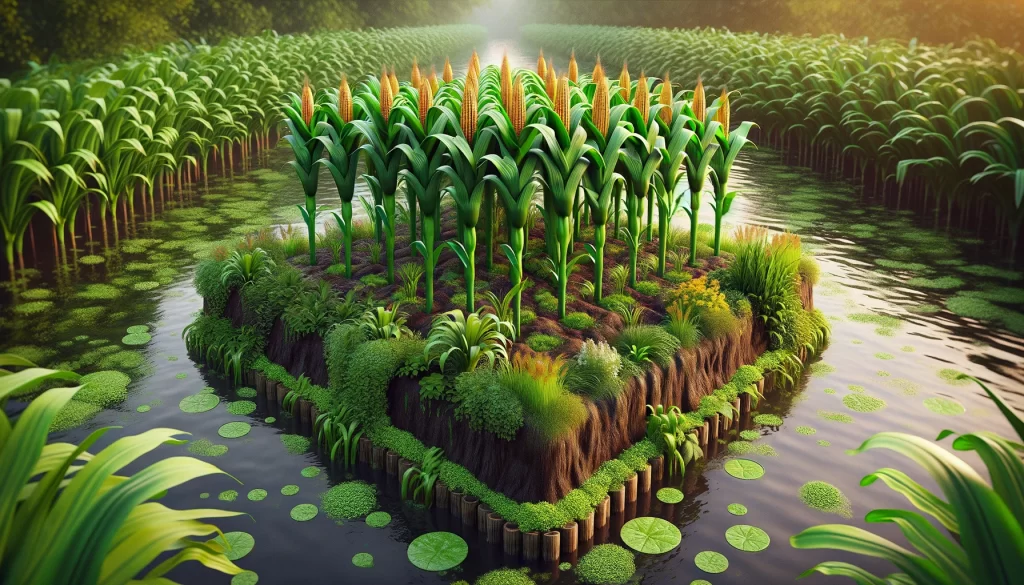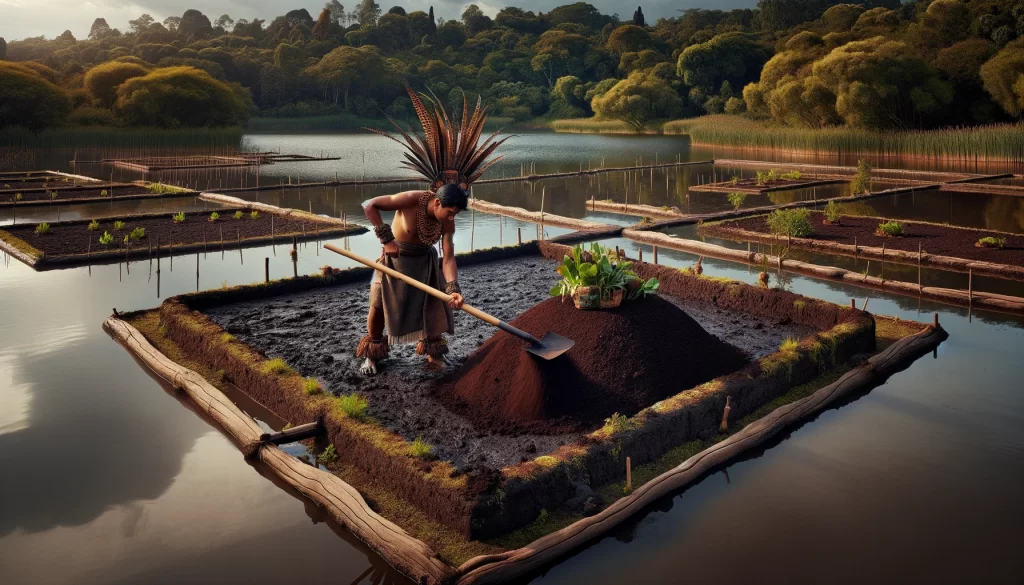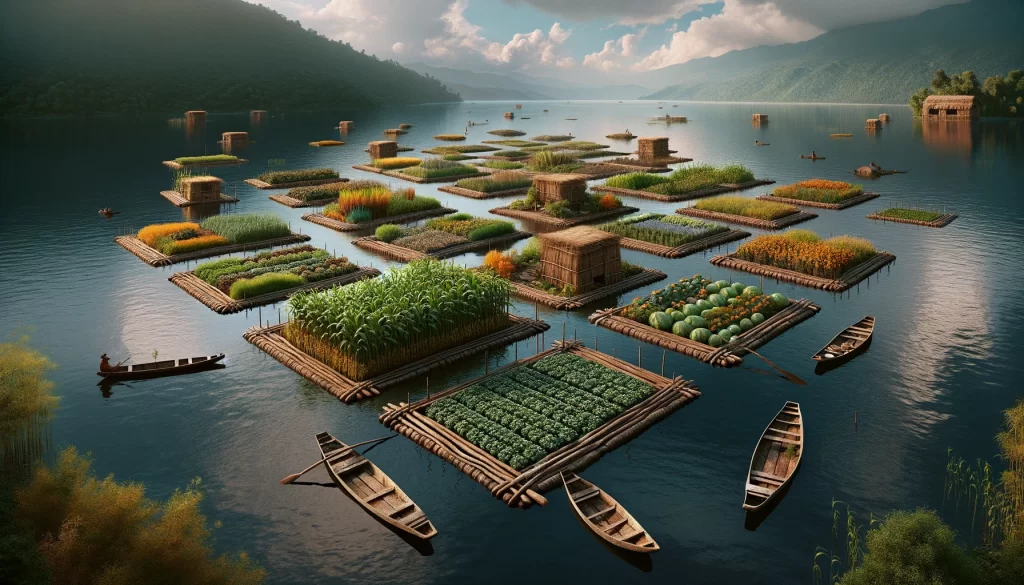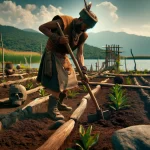Chinampas are a traditional farming system traditionally used by ancient Mesoamerican cultures and can be effectively adapted and applied in modern agriculture. Below is a step-by-step guide for farmers interested in establishing chinampas in modern times:
1. Site Selection:
- Choose an area with access to water, such as rivers, lakes, ponds, or existing irrigation systems.
- Consider the topography of the land and look for a location with a gentle slope and adequate drainage to avoid waterlogging issues.

2. Chinampa System Design:
- Plan the design and layout of the chinampas based on the shape and size of the available land.
- Decide on the size and shape of the chinampas, considering water access and irrigation capacity.
3. Chinampa Construction:
- Mark the boundaries of the chinampas on the land using stakes or ropes.
- Excavate channels between the chinampas to allow water flow. The channels should have adequate depth and width to transport irrigation water.
- Build the chinampa platforms by filling the spaces between the channels with soil, mud, and plant material such as reeds and rushes. Compact the soil well to prevent erosion.
4. Soil Preparation:
- Level and flatten the surface of the chinampas to facilitate irrigation and cultivation.
- Apply organic manure or compost to the soil to improve fertility and soil structure.
5. Planting and Cultivation:
- Select suitable crops for the chinampas, such as maize, beans, squash, chili peppers, and leafy vegetables.
- Plant seeds or seedlings following each crop’s specific recommendations regarding depth and spacing.
- Keep the chinampas free from weeds and pests through crop rotation, mulching, and integrated pest and disease management practices.
6. Irrigation and Maintenance:
- Irrigate the chinampas through controlled flooding using the previously excavated channels. Adjust the water flow according to the irrigation needs of the crops.
- Regularly monitor the water level in the chinampas and ensure adequate drainage to prevent water stagnation.
- Perform regular maintenance of the channels and chinampa structures to ensure optimal functioning of the irrigation system.
7. Harvesting and Crop Rotation:
- Harvest crops according to their maturity and quality, and replace harvested areas with new crops or cover crops to maintain soil fertility and prevent erosion.
- Practice crop rotation to avoid the buildup of diseases and depleted nutrients in the soil.
8. Monitoring and Evaluation:
- Regularly monitor crop growth, soil health, and the overall condition of the chinampas.
- Evaluate crop performance and the effectiveness of the irrigation system to identify areas for improvement and adjust management as necessary.
9. Training and Sharing Experiences:
- Train other local farmers in chinampa construction and management, sharing your knowledge and experiences.
- Establish information and learning exchange networks among farmers to promote the adoption and adaptation of sustainable agricultural practices, such as chinampas.

By following this guide, farmers can successfully establish and manage chinampas in modern agriculture, harnessing this ancient agricultural system to produce food sustainably and improve the resilience of their production systems.
Construction of surfaces with cane
Constructing surfaces with cane is a relatively simple process involving interweaving and compacting canes or other plant materials to form a solid and stable structure. Here’s a basic procedure for constructing surfaces with cane:
Materials and tools needed:
- Canes or rushes: They can be fresh or dry but should be flexible enough to interweave and resist compaction.
- Cutting tools: Pruning shears or sharp knives for cutting and preparing the canes.
- Compacting tools: Rollers, rammers, or boards for compacting and leveling the surface.
- Filling material (optional): Soil, mud, clay, or other material to fill and reinforce the constructed surface.

Procedure:
- Site Preparation:
- Select a suitable area for constructing the surface with cane, preferably on flat and well-drained land.
- Clean and level the selected area, removing any obstacles or unwanted vegetation.
- Cutting and preparing the canes:
- Cut the canes into equal lengths, usually 1 to 2 meters long, depending on the desired size of the surface.
- Sort and classify the canes according to their size and thickness, reserving the thicker and more resistant ones for the base and lower layers, and the thinner and more flexible ones for the upper layers.
- Base Construction:
- Place the thicker and more resistant canes on the ground in parallel rows, spaced evenly, to form the base of the surface.
- Interweave transverse canes between the rows of the base, forming a solid and uniform grid or lattice.
- Compact and level the base using compacting tools, such as rollers or rammers, to ensure a firm and stable surface.
- Construction of additional layers:
- Add additional layers of interwoven canes over the base, alternating the direction of the canes between layers to increase strength and stability.
- Compact and level each layer before adding the next one, ensuring the surface is uniform and well consolidated.
- Optional filling:
- If necessary, fill the spaces between the canes with soil, mud, or clay to reinforce the structure and improve resistance to water and erosion.
- Compact and level the filling to ensure a uniform and stable surface.
- Finishing and sealing:
- Inspect the constructed surface for any weak areas or defects and make adjustments or repairs as necessary.
- If greater strength or durability is required, apply a protective coating such as a layer of clay, lime, or eco-friendly paint to protect the surface from weathering and erosion.
With these steps, a solid and resistant surface with cane can be constructed, suitable for a variety of applications such as roofs, floors, walls, and shelter structures. Cane construction is a versatile and sustainable technique that has been used by many cultures worldwide for centuries.
 AgronoBlog – Agriculture Blog
AgronoBlog – Agriculture Blog 